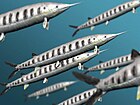
Actinopterygii, members of which are known as ray-finned fish or actinopterygians, is a class of bony fish that comprise over 50% of living vertebrate species. They are so called because of their lightly built fins made of webbings of skin supported by radially extended thin bony spines called lepidotrichia, as opposed to the bulkier, fleshy lobed fins of the sister class Sarcopterygii. Resembling folding fans, the actinopterygian fins can easily change shape and wetted area, providing superior thrust-to-weight ratios per movement compared to sarcopterygian and chondrichthyian fins. The fin rays attach directly to the proximal or basal skeletal elements, the radials, which represent the articulation between these fins and the internal skeleton.
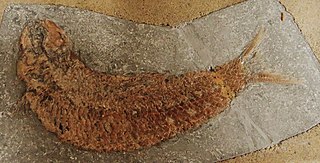
Pholidophorus is an extinct genus of stem-teleost fish. Numerous species were assigned to this genus in the past, but only the type species Pholidophorus latiusculus, from the Late Triassic of Europe, is considered to be a valid member of the genus today.

Holostei is a group of ray-finned bony fish. It is divided into two major clades, the Halecomorphi, represented by the single living genus, Amia with two species, the bowfins, as well as the Ginglymodi, the sole living representatives being the gars (Lepisosteidae), represented by seven living species in two genera. The earliest members of the clade, which are putative "semionotiforms" such as Acentrophorus and Archaeolepidotus, are known from the Middle to Late Permian and are among the earliest known neopterygians.

Acanthomorpha is an extraordinarily diverse taxon of teleost fishes with spiny fin rays. The clade contains about one-third of the world's modern species of vertebrates: over 14,000 species.

Pachycormiformes is an extinct order of marine ray-finned fish known from the Early Jurassic to the end of the Cretaceous. It only includes a single family, Pachycormidae. They were characterized by having serrated pectoral fins, reduced pelvic fins and a bony rostrum. Pachycormiformes are morphologically diverse, containing both tuna and swordfish-like carnivorous forms, as well as edentulous suspension-feeding forms.
Bobbichthys is an extinct genus of marine ray-finned fish that lived in what is now Chile during the Oxfordian stage of the Late Jurassic epoch. It was a member of the Varasichthyidae, a family of potentially crossognathiform fish.
Agecephalichthys is an extinct genus of prehistoric freshwater "palaeonisciform" ray-finned fish that lived during the Anisian age. It contains a single species, A. granulatus from the Hawkesbury Sandstone in what is now New South Wales, Australia.
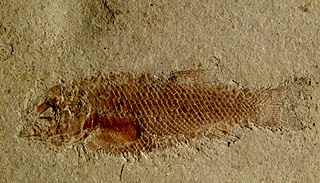
Acentrophorus is an extinct genus of prehistoric freshwater and marine ray-finned fish from the Roadian to the Wuchiapingian of England, Germany (Kupferschiefer), Italy and Russia. There may also be a Triassic occurrence in Australia.

Anaethalion is an extinct genus of prehistoric marine and freshwater ray-finned fish related to modern tarpons and ladyfish. It is known from the Late Jurassic to the Early Cretaceous of Europe and northeasterrn Asia, roughly encompassing the Tethys Ocean.
Ascalabos is an extinct genus of marine ray-finned fish known from the Late Jurassic Solnhofen Limestone of Germany. It contains one species, A. voithii. Some authorities synonymize it with Leptolepis.
Boreolepis is an extinct genus of prehistoric marine ray-finned fish that lived from the Late Kungurian to the Wuchiapingian of the Permian period. It inhabited the high northern latitudes in what is now Greenland and European Russia.
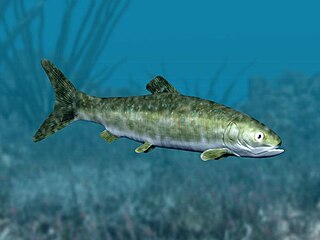
Ichthyokentema ("fish-goad") is an extinct genus of stem-teleost fish that lived during the Late Jurassic. It contains one species, I. purbeckensis, which is known from the Purbeck Group of Dorset, England. I. purbeckensis was originally described as a species of Pholidophorus by William Davies in 1887, but was moved to its own genus by Arthur Smith Woodward in 1941.

Orthocormus is an extinct genus of prehistoric pachycormiform bony fish. It is known from three species found in Late Jurassic (Kimmeridgian) aged plattenkalk deposits in Bavaria, Germany. The species "Hypsocormus" tenuirostris Woodward 1889 from the late Middle Jurassic (Callovian) Oxford Clay is not closely related to the type species of Hypsocormus, and is more closely related to Orthocormus + Protosphyraena, and thus has sometimes been referred to in open nomenclature as Orthocormus? tenuirostris. The species of Orthocormus reached over a metre in length, and are thought to have been pelagic predators.

Pholidorhynchodon is an extinct genus of ray-finned fish that lived in the Triassic. Its fossils have been found in Italy, in the Zorzino Limestone Formation in Cene.
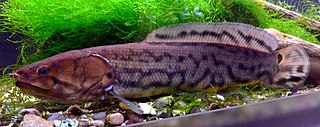
Amia, commonly called bowfin, is a genus of bony fish related to gars in the infraclass Holostei. They are regarded as taxonomic relicts, being the sole surviving species of the order Amiiformes, which dates from the Jurassic to the Eocene, persisting to the present. There are two living species in Amia, Amia calva and Amia ocellicauda, and a number of extinct species which have been described from the fossil record.

Dorsetichthys is an extinct genus of stem-teleost ray-finned fish from the Early Jurassic period of Europe.

Teleosteomorpha is a clade of ray-finned fishes containing all teleost fish and their closest extinct relatives. Also in this group are two diverse Mesozoic fish orders, the Aspidorhynchiformes and the Pachycormiformes. Several other non-teleostomorph teleosteans existed throughout the Mesozoic, although not as dominant as the two main clades in the group.
Turseodus is an extinct genus of ray-finned fish found in Late Triassic freshwater sediments of the United States. Two species have been described, T. acutus from the Lockatong Formation of Pennsylvania, and T. dolorensis from the Chinle Formation of Colorado.

Pholidophoridae is an extinct family of primitive stem-teleost fish that lived during the Triassic period, from the Anisian age of the Middle Triassic to the Norian age of the Late Triassic. Most of the genera are from Europe, but one (Malingichthys) is known from China. The pholidophorids were historically united with several other stem-teleost lineages into the order Pholidophoriformes, but Pholidophoriformes in its traditional sense is now considered paraphyletic with respect to crown group teleosts.

Marcopoloichthys is an extinct genus of marine teleosteomorph ray-finned fish known from the Middle and Late Triassic of the former Tethys Ocean. It is the only genus in the family Marcopoloichthyidae. It was originally described based on specimens from both Italy and China, hence the name Marcopoloichthys, which references the medieval Venetian merchant Marco Polo, who travelled from Italy to China.















